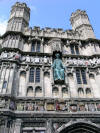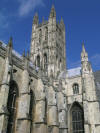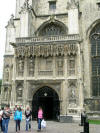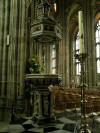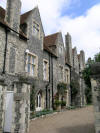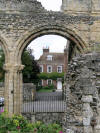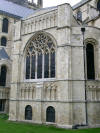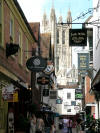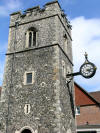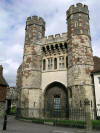Round The World and other travels
A frequent flyer's collection of trip diaries
June 2011: Canterbury
I first thought of a possible weekend break in Kent around 2006, based on the idea of using the British Airways Edinburgh-Gatwick service and picking up a rental car on arrival in the south-east of England. A few years later, the notion was rekindled when UK regional airline Flybe launched its innovative Edinburgh-Manston service. I finally got around to making the trip a reality in the summer of 2011. First stop was the historic cathedral city of Canterbury, part of which is designated a UNESCO world heritage site.
Canterbury Cathedral
The cathedral immediately strikes the visitor as being different from most in that, despite being located right in the heart of the city centre, it is surrounded by substantial private precincts with controlled entry, helping to create a sense of peace and calm, and separation from everyday life. The first cathedral on the site was founded by St Augustine, the first Archbishop of Canterbury, in AD597. Since then, the cathedral has been subject to substantial rebuilding and extension. It has seen the murder of Archbishop Thomas Becket, become a place of pilgrimage (as famously recorded in Chaucer's Canterbury Tales), suffered the destruction (by royal command) of its shrine to Thomas Becket, become part of the Church of England and eventually Mother Church of the worldwide Anglican Communion.
Today, the cathedral continues to attract large numbers of visitors and it was noticeable that many came from France and other nearby continental countries. Despite the centuries of history, I thought that the interior was a surprising blend of traditional and modern, with a strong emphasis on present-day activities as well as conservation. The crypt was closed for a service when I arrived, but opened a little later; the air was thick with the sweet scent of incense when I went down into this dimly lit area and this, together with the sound of Gregorian chant, made for a particularly atmospheric experience.
St Augustine's Abbey
In addition to founding Canterbury Cathedral, St Augustine established a large Benedictine abbey just outside the city walls. The abbey church is said to have rivalled the cathedral in stature. The entire complex fell victim to Henry VIII's dissolution of the monasteries in 1538. Part of it became a royal palace, subsequently destroyed in a violent storm in 1703. The site is now a ruin in the care of English Heritage.
Other areas
Canterbury also boasts a city wall, a ruined castle, a number of historic city-centre buildings, the oldest parish church in England and some attractive gardens and parkland along the banks of the River Stour. Sadly, much of the city centre is blighted by those horribly brash and tasteless shop fronts that have infested virtually every high street in the UK.
